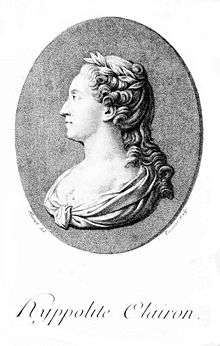La Clairon
| Hippolyte Clairon | |
|---|---|
 Hippolyte Clairon | |
| Born |
Clair Josèphe Hippolyte Leris 25 January 1723 Condé-sur-l'Escaut, Hainaut |
| Died | 29 January 1803 (aged 80) |
| Burial place | Père Lachaise Cemetery |
| Other names | La Clairon |
| Occupation | Actress, writer |
| Partner(s) | Charles Alexander, Margrave of Brandenburg-Ansbach |
La Clairon (25 January 1723 – 29 January 1803), French actress, whose real name was Clair Josèphe Hippolyte Leris, was born at Condé-sur-l'Escaut, Hainaut, the daughter of an army sergeant.
In 1736 she made her first stage appearance at the Comédie Italienne, a small part in Pierre de Marivaux's L'Île des esclaves. After several years in the provinces she returned to Paris. Her life, meanwhile, had been decidedly irregular, even if not to the degree indicated by the libellous pamphlet Histoire de la demoiselle Cronel', dite Frétillon, actrice de la Comédie de Rouen, écrite par elle-mme (The Hague, 1746), or to be inferred from the disingenuousness of her own Mémoires d'Hippolyte Clairon (1798); and she had great difficulty in obtaining an order to make her debut at the Comédie-Française. Succeeding, however, at last, she had the courage to select the title-role of Phèdre, and she obtained a veritable triumph. During her twenty-two years at this theatre, dividing the honors with her rival Marie Françoise Dumesnil, she filled many of the classical roles of tragedy, and created a great number of parts in the plays of Voltaire, Marmontel, Bernard-Joseph Saurin, de Belloy and others.
She retired in 1766, and trained pupils for the stage, among them Mlle Raucourt. Oliver Goldsmith called Mlle Clairon "the most perfect female figure I have ever seen on any stage" (The Bee, 2nd No.); and David Garrick, recognizing her unwillingness or inability to make use of the inspiration of the instant, admitted that she has everything that art and a good understanding with great natural spirit can give her.
She was a mistress of Charles Alexander, Margrave of Brandenburg-Ansbach, who renovated his "White Castle" at his country seat and hunting estate in Triesdorf for her.
See also
External links
| Wikimedia Commons has media related to Mademoiselle Clairon. |
References
 This article incorporates text from a publication now in the public domain: Chisholm, Hugh, ed. (1911). "Clairon, La". Encyclopædia Britannica. 6 (11th ed.). Cambridge University Press. p. 418.
This article incorporates text from a publication now in the public domain: Chisholm, Hugh, ed. (1911). "Clairon, La". Encyclopædia Britannica. 6 (11th ed.). Cambridge University Press. p. 418.